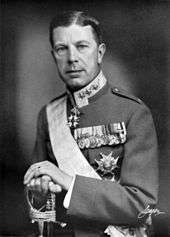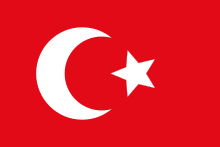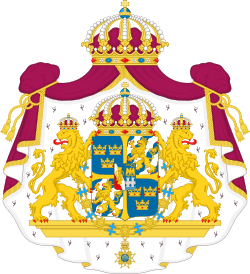Gustaf VI Adolf of Sweden
| Gustaf VI Adolf | |||||
|---|---|---|---|---|---|
 King Gustaf VI Adolf in 1962 | |||||
| King of Sweden | |||||
| Reign | 29 October 1950 – 15 September 1973 | ||||
| Predecessor | Gustaf V | ||||
| Successor | Carl XVI Gustaf | ||||
| Prime Ministers |
See list
| ||||
| Born |
11 November 1882 The Royal Palace in Stockholm | ||||
| Died |
15 September 1973 (aged 90) Helsingborg hospital, Helsingborg, Sweden | ||||
| Burial | Royal Cemetery, Solna | ||||
| Spouse |
Princess Margaret of Connaught (m. 1905; her death 1920) Lady Louise Mountbatten (m. 1923; her death 1965) | ||||
| Issue |
Prince Gustaf Adolf, Duke of Västerbotten Sigvard Bernadotte Ingrid, Queen of Denmark Prince Bertil, Duke of Halland Carl Johan Bernadotte | ||||
| |||||
| House | Bernadotte | ||||
| Father | Gustaf V of Sweden | ||||
| Mother | Victoria of Baden | ||||
| Religion | Church of Sweden | ||||
Gustaf VI Adolf (Oscar Fredrik Wilhelm Olaf Gustaf Adolf; 11 November 1882 – 15 September 1973) was King of Sweden from 29 October 1950 until his death. He was the eldest son of King Gustaf V and his wife, Victoria of Baden, and had been Crown Prince of Sweden for the preceding 43 years in the reign of his father.
Gustaf VI Adolf was a lifelong amateur archeologist particularly interested in Ancient Italian cultures.
Birth
He was born at the Royal Palace in Stockholm and at birth created Duke of Skåne. A patrilineal member of the Bernadotte family, he was also a descendant of the House of Vasa through maternal lines. Through his mother, Victoria, he was a descendant of Gustav IV Adolf of Sweden of the deposed House of Holstein-Gottorp.
Crown Prince (1907–1950)

Gustaf Adolf became Crown Prince of Sweden on 8 December 1907, at the death of his grandfather, King Oscar II.
In 1938 he was elected an honorary member of the Virginia Society of the Cincinnati.
Reign (1950–1973)
On 29 October 1950, Crown Prince Gustaf Adolf became king at age 67 upon the death of his father, King Gustaf V. He was at the time the world's oldest heir apparent to a monarchy. His personal motto was Plikten framför allt, "Duty before all".
During Gustaf VI Adolf's reign, work was underway on a new Instrument of Government to replace the 1809 constitution and produce reforms consistent with the times. Among the reforms sought by some Swedes was the replacement of the monarchy or at least some moderation of the old constitution's provision that "The King alone shall govern the realm."
Gustaf VI Adolf's personal qualities made him popular among the Swedish people and, in turn, this popularity led to strong public opinion in favour of the retention of the monarchy. Gustaf VI Adolf's expertise and interest in a wide range of fields (architecture and botany being but two) made him respected, as did his informal and modest nature and his purposeful avoidance of pomp. While the monarchy had been de facto subordinate to the Riksdag and ministers since 1917, the king still nominally retained considerable reserve powers. Even these nominal powers were removed when Sweden's constitutional reform became complete in 1975, thus making Gustaf Adolf the last monarch to wield even nominal political power.
The King died in 1973, ten weeks shy of his 91st birthday, at the old hospital in Helsingborg, Scania, close to his summer residence, Sofiero Castle, after a deterioration in his health that culminated in pneumonia. He was succeeded on the throne by his 27-year-old grandson Carl XVI Gustaf, son of the late Prince Gustaf Adolf. He died the day before the election of 1973, which is suggested to have swayed it in support of the incumbent Social Democratic government.[1] In a break with tradition, he was not buried in Riddarholmskyrkan in Stockholm, but in the Royal Cemetery in Haga alongside his two deceased wives. He was the last surviving son of Gustaf V.
Personal interests

The King's reputation as a "professional amateur professor" was widely known; nationally and internationally, and among his relatives. Gustaf VI Adolf was a devoted archaeologist, and was admitted to the British Academy for his work in botany in 1958. Gustaf VI Adolf participated in archaeological expeditions in China, Greece, Korea and Italy, and founded the Swedish Institute in Rome.
Gustaf VI Adolf had an enormous private library consisting of 80 000 volumes and – nearly more impressively – he actually had read the main part of the books. He had an interest in specialist literature on Chinese art and East Asian history. Throughout his life, King Gustaf VI Adolf was particularly interested in the history of civilization, and he participated in several archaeological expeditions. His other great area of interest was botany, concentrating in flowers and gardening. He was considered an expert on the Rhododendron flower. At Sofiero Castle (the king's summer residence) he created one of the very finest Rhododendron collections.
Like his son, Prince Bertil, Gustaf VI Adolf maintained wide, lifelong interests in sports. He enjoyed tennis and golf, and fly fishing for charity.
Family and issue

_Adolf_of_Sweden_w_fam_07729v.jpg)
Gustaf Adolf married Princess Margaret of Connaught on 15 June 1905 in St. George's Chapel, at Windsor Castle. Princess Margaret was the daughter of Prince Arthur, Duke of Connaught, third son of Queen Victoria and Prince Albert of the United Kingdom.
King Gustaf VI Adolf and Crown Princess Margaret of Sweden had five children:
| Name | Birth | Death | Notes |
|---|---|---|---|
| Prince Gustaf Adolf, Duke of Västerbotten | 22 April 1906 | 26 January 1947 (aged 40) | died in a plane crash at Copenhagen Airport, father of King Carl XVI Gustaf of Sweden |
| Prince Sigvard, Duke of Uppland | 7 June 1907 | 4 February 2002 (aged 94) | later Sigvard Count of Wisborg |
| Princess Ingrid | 28 March 1910 | 7 November 2000 (aged 90) | later Queen of Denmark; wife of Frederick IX of Denmark and mother of the present Queen Margrethe II of Denmark and Queen Anne-Marie of Greece |
| Prince Bertil, Duke of Halland | 28 February 1912 | 5 January 1997 (aged 84) | married Lillian Davies, no issue |
| Prince Carl Johan, Duke of Dalarna | 31 October 1916 | 5 May 2012 (aged 95) | later Carl Johan Count of Wisborg. |
Crown Princess Margaret died suddenly on 1 May 1920 of an infection following surgery. At the time, she was eight months pregnant and expecting her sixth child.
He married Lady Louise Mountbatten, formerly Princess Louise of Battenberg, on 3 November 1923 at St. James's Palace.[2] She was the sister of Lord Mountbatten and aunt of Prince Philip, Duke of Edinburgh. It was Lady Louise who became Queen of Sweden. Both Queen Louise and her stepchildren were great-grandchildren of Queen Victoria of the United Kingdom.
Gustaf Adolf's second marriage to Louise produced only one stillborn daughter on 30 May 1925.
While his first wife visited her native Britain in the early years of their marriage, it was widely rumored in Sweden that Gustaf Adolf had an affair there with operetta star Rosa Grünberg.[3] Swedish vocalist Carl-Erik Olivebring (1919–2002) in a press interview claimed to be an extramarital son of Gustaf VI Adolf, a claim taken seriously by the king's biographer Kjell Fridh (1944–1998).[4]
King Gustaf VI Adolf of Sweden was the grandfather of his direct successor King Carl XVI Gustaf of Sweden, Queen Margrethe II of Denmark and former Queen Anne-Marie of Greece.
Titles, styles, honours and arms
| ||||||||||
Titles and styles
- 11 November 1882 – 8 December 1907: His Royal Highness The Duke of Skåne, Prince of Sweden
- 8 December 1907 – 29 October 1950: His Royal Highness The Crown Prince of Sweden, Duke of Skåne
- 29 October 1950 – 15 September 1973: His Majesty The King of Sweden
His title used in official documents was: Gustaf Adolf, by the Grace of God, Sweden's, Gothia's and Wendia's King (Swedish: Gustaf Adolf, med Guds nåde, Sveriges, Götes och Vendes Konung).
Honours
Swedish
- Official Orders
-
 Lord and Master (and Knight with Collar from birth) of the Order of the Seraphim
Lord and Master (and Knight with Collar from birth) of the Order of the Seraphim -
 Lord and Master (and Commander Grand Cross from birth) of the Order of the Sword
Lord and Master (and Commander Grand Cross from birth) of the Order of the Sword -
 Lord and Master (and Commander Grand Cross from birth) of the Order of the Polar Star
Lord and Master (and Commander Grand Cross from birth) of the Order of the Polar Star -
 Lord and Master (and Commander Grand Cross) of the Order of Vasa
Lord and Master (and Commander Grand Cross) of the Order of Vasa -
 Lord and Master (and Knight by birth) of the Order of Charles XIII
Lord and Master (and Knight by birth) of the Order of Charles XIII
- Quasi-Official Orders
- High Protector (and Honorary Knight) of the Order of Saint John in Sweden
- Official Medals
- King Oscar II:s Jubilee Commemorative Badge (1897)
- King Oscar II:s and Sophia's Golden Wedding Commemorative Badge (1907)
- King Gustaf V:s Commemorative Badge for his 70th birthday (1928)
- King Gustaf V:s Commemorative Badge for his 90th birthday (1948)
- Crown Prince Gustaf's and Victoria's Silver Wedding Commemorative Badge (1906)
- The Medal Illis Quorum Meruere Labores of the 18th size
Foreign
- Austria
-
 Great Star of Honour for Services to the Republic of Austria (1960)[5]
Great Star of Honour for Services to the Republic of Austria (1960)[5] -
.svg.png) Knight Grand Cross of the Order of Saint Stephen of Hungary (Austro-Hungarian Empire)
Knight Grand Cross of the Order of Saint Stephen of Hungary (Austro-Hungarian Empire)
-
-
.svg.png) Grand Cordon of the Order of Leopold
Grand Cordon of the Order of Leopold -

- Knight of the Order of the Elephant (1903)
- Grand Commander of the Order of Dannebrog (24 March 1952)
-
.svg.png) Collar of the Order of Mohammed Ali
Collar of the Order of Mohammed Ali -
 Commander Grand Cross with Collar of the Order of the White Rose
Commander Grand Cross with Collar of the Order of the White Rose -
 Knight Grand Cross of the Legion of Honour
Knight Grand Cross of the Legion of Honour - Germany
-
 Grand Cross Special Class of the Order of Merit of the Federal Republic of Germany
Grand Cross Special Class of the Order of Merit of the Federal Republic of Germany -
.svg.png) Knight of the Order of the Black Eagle
Knight of the Order of the Black Eagle -
.svg.png) Commander of the Order of the Red Eagle
Commander of the Order of the Red Eagle -
.svg.png) Knight Grand Cross of the House Order of Fidelity
Knight Grand Cross of the House Order of Fidelity -
 House and Merit Order of Peter Frederick Louis
House and Merit Order of Peter Frederick Louis -
.svg.png) Knight Grand Cross of the Saxe-Ernestine House Order
Knight Grand Cross of the Saxe-Ernestine House Order -
.svg.png) Knight Grand Cross of the Order of the Rue Crown
Knight Grand Cross of the Order of the Rue Crown
-
-
.svg.png) Knight Grand Cross of the Order of the Redeemer
Knight Grand Cross of the Order of the Redeemer -
 Knight Grand Cross decorated with Collar of the Order of the Falcon
Knight Grand Cross decorated with Collar of the Order of the Falcon -
.svg.png) Grand Collar of the Order of Pahlavi
Grand Collar of the Order of Pahlavi -
.svg.png) Order of Al Rafidain
Order of Al Rafidain - Italy
-
 Knight Grand Cross decorated with Grand Cordon of the Order of Merit of the Italian Republic (14 June 1966)
Knight Grand Cross decorated with Grand Cordon of the Order of Merit of the Italian Republic (14 June 1966) -
_crowned.svg.png) Knight of the Supreme Order of the Most Holy Annunciation (1905)
Knight of the Supreme Order of the Most Holy Annunciation (1905) -
_crowned.svg.png) Knight Grand Cross of the Order of Saints Maurice and Lazarus (1905)
Knight Grand Cross of the Order of Saints Maurice and Lazarus (1905) -
_crowned.svg.png) Knight Grand Cross of the Order of the Crown of Italy (1905)
Knight Grand Cross of the Order of the Crown of Italy (1905)
-
-
 Collar of the Order of the Chrysanthemum
Collar of the Order of the Chrysanthemum -
 Knight Grand Cross of the Order of the Netherlands Lion
Knight Grand Cross of the Order of the Netherlands Lion -

- Commander of the Order of St. Olav
- Knight Grand Cross of the Order of the Norwegian Lion
-
 Knight of the Order of Osmanieh, 1st Class
Knight of the Order of Osmanieh, 1st Class -
 Order of the Sun with diamonds
Order of the Sun with diamonds -
 Knight Grand Cross of the Order of the Tower and Sword
Knight Grand Cross of the Order of the Tower and Sword -

- Knight of the Order of St. Andrew
- Knight of the Order of St. Alexander Nevsky
- Knight Grand Cross of the Order of Saint Stanislaus
- Knight of The Class of the Order of St. Anna, 1st class
- Knight of the Order of the White Eagle
-
 Knight of the Order of the Golden Fleece (31 January 1910, 1126th Knight)[6]
Knight of the Order of the Golden Fleece (31 January 1910, 1126th Knight)[6] -
 Royal Knight of the Order of the Royal House of Chakri
Royal Knight of the Order of the Royal House of Chakri -

- Stranger Knight of the Order of the Garter (1954, 913th member)
- Honorary Knight Grand Cross of the Order of the Bath[7]
- Recipient of the Royal Victorian Chain[8]
- Honorary Knight Grand Cross of the Royal Victorian Order
- Honorary degrees

In 1918, Gustaf VI Adolf received an honorary doctorate at Lund University, in 1926 an Honorary Doctorate at Yale, Princeton and Clark Universities, at Cambridge in 1929 and in 1932 at the University of Dorpat.
Arms & Monogram
Upon his creation as Duke of Skåne, Gustaf Adolf was granted a coat of arms with the arms of Skåne in base. These arms can be seen on his stall-plates both as Knight of the Swedish order of the Seraphim in the Riddarsholmskyrkan in Sweden, but also the Frederiksborg Chapel in Copenhagen, Denmark, as an Knight of the Danish Order of the Elephant. Upon his accession to the throne in 1950, he assumed the Arms of Dominion of Sweden.
 and Duke of Scania 1882 to 1905 |
2.svg.png) Duke of Scania 1907 to 1950 |
 also the King's coat of arms |
 |
Ancestors
References
| Wikimedia Commons has media related to Gustaf VI Adolf of Sweden. |
- ↑ Magnusson, Jane (25 November 2011). "När Martin Luther King träffade kungen". Dagens Nyheter (in Swedish). Retrieved 22 March 2016.
- ↑ "Lady Louise Mountbatten". Mariees du Gotha.
- ↑ Elgklou, Lars (1978). Bernadotte: historien - och historier - om en familj (in Swedish). Stockholm: Askild & Kärnekull. p. 170. ISBN 91-7008-882-9. LIBRIS 7589807.
- ↑ Fridh, Kjell (1995). Gamle kungen: Gustaf VI Adolf : en biografi (in Swedish). Stockholm: Wahlström & Widstrand. ISBN 91-46-16462-6. LIBRIS 7281986.
- ↑ "Reply to a parliamentary question" (pdf) (in German). National Council. p. 95. Retrieved 5 October 2012.
- ↑ Boletín Oficial del Estado. boe.es. 1 February 1910. Vol. L, #32, p. 253
- ↑ http://www.thepeerage.com/100771_001.jpg
- ↑ http://www.thepeerage.com/100771_001.jpg
| Gustaf VI Adolf of Sweden Born: 11 November 1882 Died: 15 September 1973 | ||
| Regnal titles | ||
|---|---|---|
| Preceded by Gustaf V |
King of Sweden 1950–1973 |
Succeeded by Carl XVI Gustaf |
| Swedish royalty | ||
| Preceded by Gustaf |
Crown Prince of Sweden 1907–1950 |
Succeeded by Carl Gustaf |
| Vacant Title last held by Charles XV |
Duke of Skåne 1882–1950 |
Vacant Title next held by Prince Oscar |
| Sporting positions | ||
| Preceded by Edward VII of the United Kingdom |
President of Organizing Committee for Summer Olympic Games 1912 |
Succeeded by |